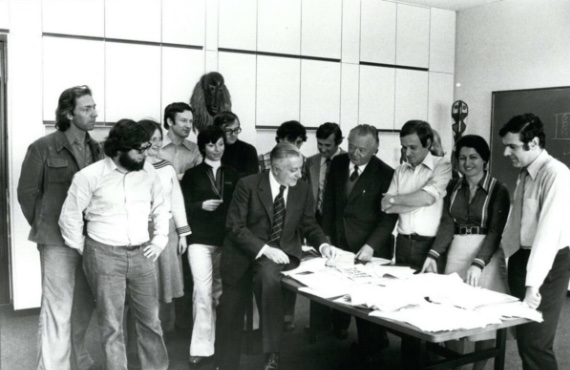British astronomer Fred Hoyle said that the chances of life arising spontaneously on Earth were the same as a whirlwind blowing through a junkyard and resulting in the assembly of a Boeing 747 ready to fly. Although Hoyle’s scepticism has been refuted by evolutionary biologists, the question nevertheless remains: if, as the laws of thermodynamics dictate, the universe is always flowing towards greater disorder—or entropy—how could something as organised as life emerge from chaos? In the 1960s, a Russian-Belgian chemist named Ilya Prigogine developed a theory that solved this conundrum so brilliantly that he was awarded the Nobel Prize.
Ilya Romanovich Prigogine (25 January 1917 – 28 May 2003) was born in Moscow at a complicated historical moment, just as the revolution that would radically change the course of Russia for decades to come was about to be ignited. His family did not belong to the proletariat: his father, a chemical engineer, ran a small soap factory, and his mother was a pianist. In 1921, the family fled what Ilya himself described as “a difficult relationship with the new regime,” first to Lithuania for a year and then to Berlin, before settling in Brussels in 1929, where Ilya became a Belgian citizen in 1949.
Although his family encouraged him to study chemistry at the Université Libre de Bruxelles, that was not the path his inclinations suggested. As he recounted in his autobiographical essay for the Nobel Prize, he was more interested in history, archaeology and music, especially the piano, an instrument he never gave up; he said that he learned to read sheet music before printed words. However, this attraction to the humanities would be decisive in his turning away from the more practical chemistry chosen by his father and older brother—the latter would make a career in the mining industry in the former Belgian Congo—and instead seek more philosophical ground. As he himself wrote: “Maybe the orientation of my work came from the conflict which arose from my humanist vocation as an adolescent and from the scientific orientation I chose for my university training.”

He was particularly fascinated by the concept of time, which he explored through the work of the French philosopher Henri Bergson. This was not the most orthodox inspiration for a scientist, as Bergson was known for his rejection of rationalism and science in favour of intuition and subjective experience. But in an age when time was just one variable in equations that could work both ways, the idea of unpredictability that he found in Bergson may have broadened his vision to take a step back and look at physico-chemical natural processes more broadly. Finally, there was another essential ingredient in his cocktail of influences: his mentor and doctoral supervisor, Théophile de Donder, who specialised in thermodynamics.
The theory of dissipative structures
Prigogine found a limitation in the thermodynamics of his time: it applied only to systems at or near equilibrium. This idealisation of nature left out a wide range of processes, such as the emergence and evolution of life itself, processes that are far from equilibrium and which, because they are irreversible, have a clear direction of the arrow of time, contrary to what occurred in the physical equations used at the time. The thermodynamics of irreversible processes was the subject in which Prigogine continued the work begun by his mentor, considered the father of this discipline.

The second law of thermodynamics was where all these problems came to light. In its original form, formulated by Rudolf Clausius in 1850, this principle stated that heat does not spontaneously pass from a colder body to a warmer one. Later, Clausius introduced entropy, a physical quantity interpreted as the state of disorder of a system, and the second law was seen as an obligatory increase in total entropy in natural processes moving towards equilibrium.
But Prigogine asked himself: given the laws of thermodynamics, how is it possible for life to arise, a spontaneous process, clearly irreversible, with a specific direction in time, far from equilibrium, and in which order is born out of disorder? To explain this, he formulated the theory of so-called dissipative structures, complex systems that absorb matter and energy from the exterior to build a greater internal organisation, without the whole violating the second law of thermodynamics.
An example of these self-organising systems can be seen in something as mundane as cooking. When we heat a broth or sauce on the stove, we hear the typical bubbling sound near the boiling point, formed by a regular pattern of hexagonal convection cells in which the hotter, less dense liquid rises to the surface and sinks back to the bottom. This effect was described by the French physicist Henri Bénard in 1900, and is known as Rayleigh-Bénard convection. Prigogine chose it as an example of a dissipative system because the fluid acquires a higher degree of internal self-organisation thanks to the energy—the heat from the stove—that it absorbs from the outside. Another example cited by Prigogine is the Turing Mechanism, by which the father of computer science, the English mathematician Alan Turing, proposed that patterns in nature, such as the dots or stripes on the skin of many animals, can arise naturally.
From the origin of life to the “butterfly effect”
In 1977, Prigogine was awarded the Nobel Prize in Chemistry “for his contributions to non-equilibrium thermodynamics, particularly the theory of dissipative structures”. But beyond this somewhat abstract description, his theory made it at least physically possible for life on Earth to arise from a disordered mixture of primary components, even if, as Hoyle objected, the probability is minuscule. The theory broke with what Prigogine saw as the determinism that had prevailed in physics from Newton to Schrödinger, and that had limited the understanding of countless phenomena in nature, especially in biology, that did not respond to the predictability dictated by a system of equations.

But in addition to biology, Prigogine’s dissipative systems have influenced other fields of science, such as the study of hurricanes, in which the wind adopts a spontaneously organised pattern as it absorbs heat from the sea; or oscillatory chemical reactions, such as the Belousov-Zhabotinsky reaction, which moves between two states and has inspired the current development of chemical computing as an alternative proposal for artificial intelligence closer to the human brain. Dissipative systems have even been applied to human societies: cities, for example, absorb matter and energy from the external environment to organise themselves, acquiring collective tendencies that are absent in isolated individuals.
And, of course, dissipative systems were also one of the major influences of chaos theory, which emerged from the study of meteorological weather by the physicist Edward Lorenz and was popularised by the idea of the “butterfly effect”. Chaotic systems are complex, non-linear systems in which an infinitesimal variation produces a large effect, but this apparently random or unpredictable nature also obeys certain laws. In short, as Prigogine wrote, the aim is to “filtrate music out of noise”. He was not called the “poet of thermodynamics” for nothing.
Comments on this publication